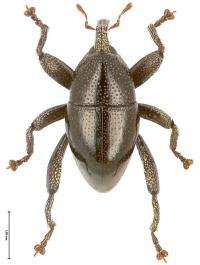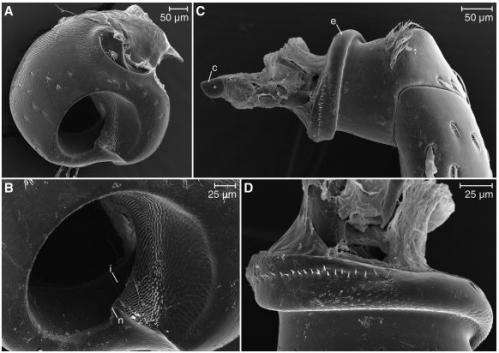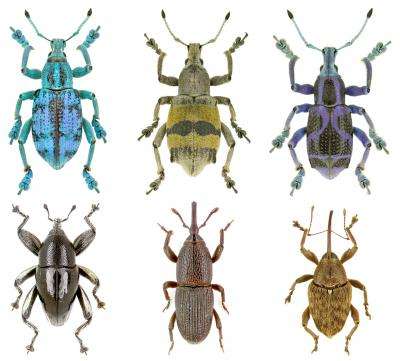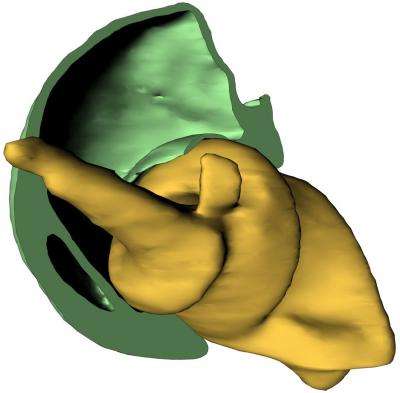July 1, 2011 report
Papuan weevil has screw-in legs

(PhysOrg.com) -- New research has found that humans were not the first species to invent the nut and bolt mechanism for screwing one thing to another: weevils do the same to attach their legs to their bodies instead of using the more familiar ball-and-socket joint.
Scientists from the Institute for Synchrotron Radiation at the Karlsruhe Institute of Technology (ANKA) and the State Museum of Natural History in Karlsruhe in Germany, led by Thomas van der Kamp, have been studying Trigonopterus, a genus of 90 described species of flightless weevils originating in tropical forest regions of New Guinea, Sumatra, the Philippines, Samoa and New Caledonia. Scientists estimate there could be as many as 1,000 undescribed species in the genus.
Weevils are herbivorous beetles of the Curculionoidea superfamily represented by over 60,000 species found world-wide. The most widely known species are Sitophilus granaries, which is often found in stored grains and other dried foods, and Anthonomus grandis or boll weevil, known for its damage to cotton crops.

Van der Kamp and colleagues studied computed tomography (CT) scans of the Papuan weevil Trigonopterus oblongus and discovered the top section of the weevil’s legs are attached to the body via the trochanter, which screws into another small body part called the coxa, which is equivalent to a hip. The joint was previously thought to be of a hinge type.
The inside of the coxa and external surface of the trochanter features threads like those found in nuts and bolts. The threads on the trochanters cover around 410 degrees or more than a complete rotation, while the internal threads on the coxa cover 345 degrees.

The muscles turn the legs on the screw threads, an arrangement that allows the weevils to twist their hind and middle legs through 130 degrees, and their front legs through 90 degrees. The joint is more difficult to dislocate than a ball-and-socket joint.
Van der Kamp then examined the legs of 15 more weevil species from different families to see if the same arrangement was used and discovered they did have a nut and bolt system like T. oblongus. The researchers suggested that “it’s a safe bet that all weevils have it.”

The T. oblongus weevil lives among leaf litter and twigs, and having a screw-around leg could be useful for helping it to find footholds while searching for food. The arrangement is also likely to give the beetle added stability in its resting posture. It is likely that the earliest weevils also lived among forest leaf litter, which could explain why weevils that no longer live in the same type of habitat have the same mechanism for leg attachment.
The paper was published today in Science.
More information: A Biological Screw in a Beetle’s Leg, Science 1 July 2011: Vol. 333 no. 6038 p. 52. DOI:10.1126/science.1204245
ABSTRACT
The coxa-trochanteral joints on the legs of the weevil Trigonopterus oblongus (Pascoe) work as a biological screw-and-nut system. The apical portions of the coxae closely resemble nuts with well-defined inner threads covering 345°. The corresponding trochanters have perfectly compatible external spiral threads of 410°.
© 2010 PhysOrg.com















